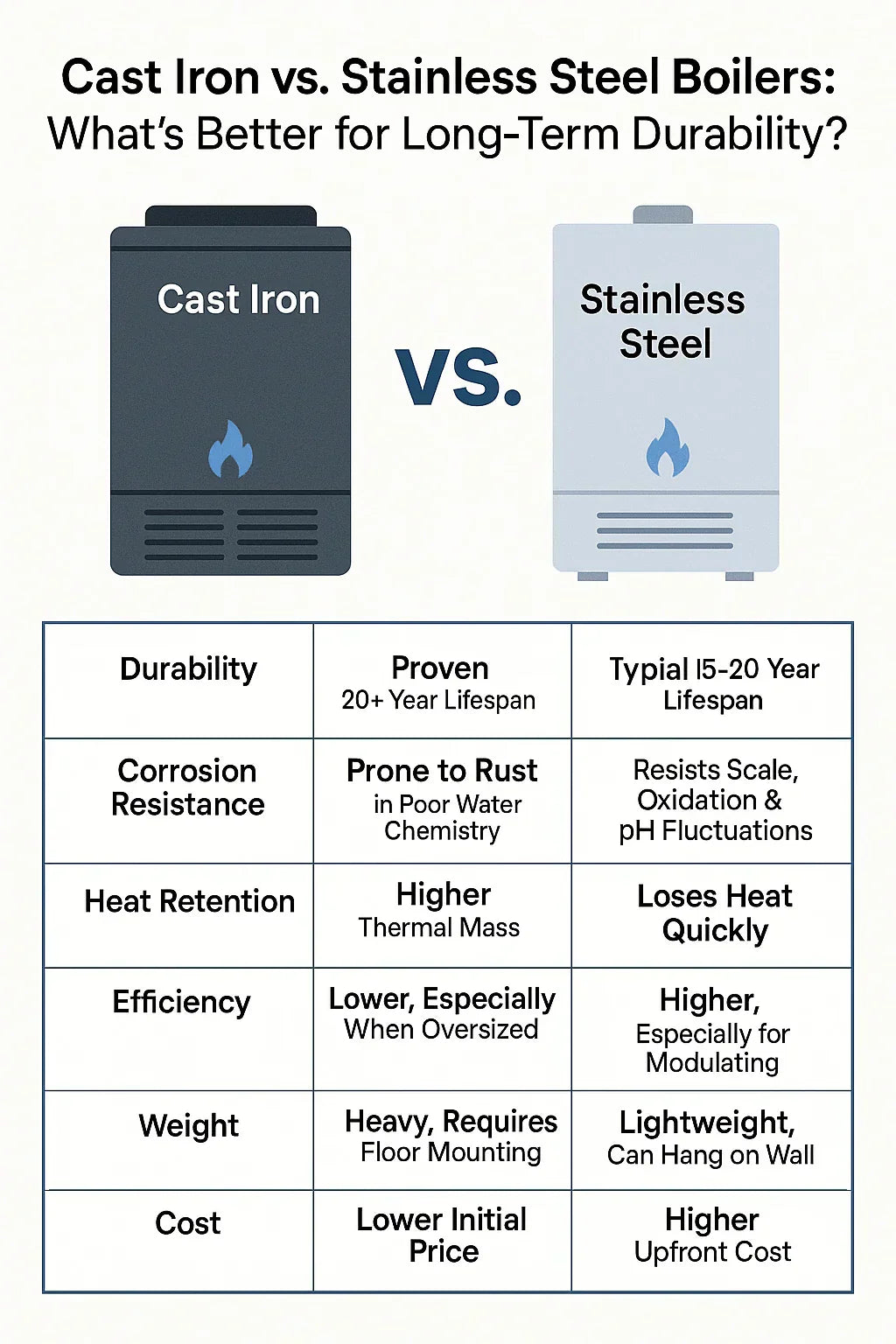When you're investing in a home heating system, the internal material isn't just a technicality—it's the foundation of long-term performance. For Mike Sanders, a smart, experienced homeowner who values durability, reliability, and upfront honesty from his equipment, choosing between cast iron and stainless steel boilers is a decision that affects comfort, cost, and peace of mind for decades.
This guide breaks down the pros and cons of cast iron vs. stainless steel boilers with real-world insight and manufacturer-backed data.
🧱 Cast Iron Boilers: Proven, Rugged, and Familiar
🔹 What Is a Cast Iron Boiler?
Cast iron boilers use heavy cast iron sections to hold water and transfer heat. They’ve been used for over 100 years, and their design is time-tested. The Weil-McLain CGA-4 is a perfect example of this type.
🔍 Benefits
-
Longevity: Often lasts 30+ years with proper care
-
Thermal Mass: Thick cast iron retains heat and minimizes temperature swings
-
Simple Maintenance: Fewer moving parts than condensing boilers
-
Reliability in Old Systems: Ideal for gravity-fed or large-radiator setups
⚠️ Drawbacks
-
Weight: Very heavy; tougher and costlier to install
-
Lower Efficiency: Most are 80–86% AFUE (non-condensing)
-
Corrosion Risk if Leaks Occur: Internal water leaks or oxygen infiltration can cause rust
🧪 Stainless Steel Boilers: Modern, Light, and High-Efficiency
🔹 What Is a Stainless Steel Boiler?
Stainless steel boilers are most common in modern high-efficiency condensing systems. They use lighter heat exchangers designed to withstand the acidic condensate created by low-temperature operation.
🌟 Benefits
-
High Efficiency: Up to 95% AFUE ratings in ENERGY STAR models
-
Lighter Installation: Easier to transport and install
-
Compact Size: Ideal for tight utility rooms
-
Advanced Controls: Often paired with modulating gas valves and smart thermostats
⚠️ Drawbacks
-
More Maintenance: Requires annual flushing and pH level monitoring
-
Shorter Lifespan: Typical life expectancy is 15–20 years
-
Sensitive to Water Quality: Hard or acidic water can damage heat exchangers
🆚 Head-to-Head: Cast Iron vs. Stainless Steel Boilers
| Feature | Cast Iron Boiler | Stainless Steel Boiler |
|---|---|---|
| Lifespan | 25–35 years | 15–20 years |
| Efficiency (AFUE) | 80–86% | 90–95% |
| Installation Weight | Heavy | Lightweight |
| Maintenance Frequency | Low (1–2x/decade service) | High (annual flushing recommended) |
| Water Quality Sensitivity | Medium | High |
| Ideal Use Case | Radiator systems, older homes | New builds, radiant floor systems |
🧰 Real-World Application: What Mike Sanders Needs to Know
Mike owns a 2,000 sq. ft., well-insulated home in a cold region. He’s not chasing the absolute highest efficiency—he’s after value and longevity. Here’s why the cast iron CGA-4 wins for him:
-
It will integrate well with his existing radiators
-
It's built for decades of life with minimal service
-
He's not dealing with high-acid condensate or complex venting
However, if Mike were in a newer home with radiant floor heating, or prioritizing carbon savings, a stainless steel condensing unit might offer faster returns.
🌐 External Resources for Deep Dive
✅ Bottom Line: Which One Should You Buy?
-
Choose cast iron if you want proven reliability, long-term durability, and simple service—even at slightly lower efficiency.
-
Choose stainless steel if you have excellent water quality, newer hydronic layouts, and prefer high AFUE ratings with modulating controls.
For Mike Sanders—and homeowners like him—the Weil-McLain CGA-4 delivers excellent value, especially in older or traditional radiator homes.
In the next topic we will know more about: How Much Does a Weil-McLain CGA-4 Boiler Installation Cost in 2025?







